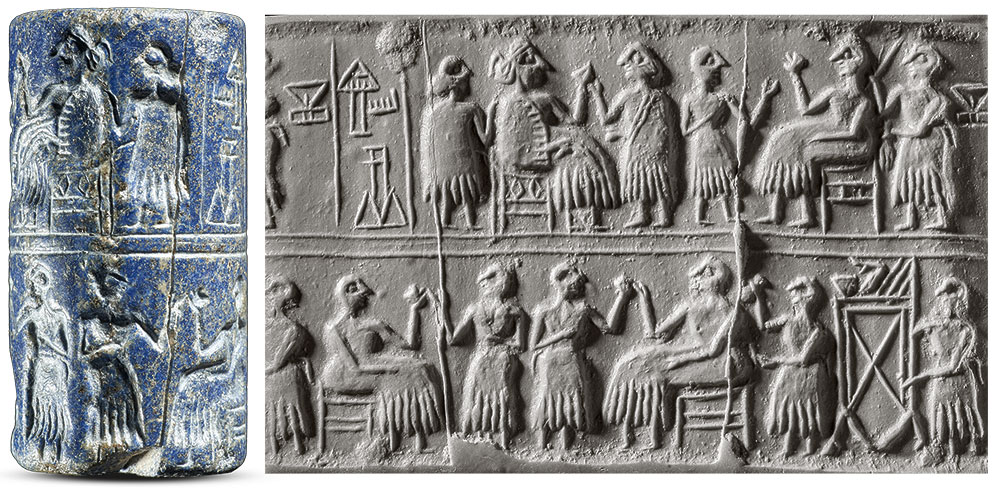 Seated in the top register of this banquet scene, Queen Puabi is first announced by the seal’s inscription, which names her specifically. Puabi’s chair is more decorative than those of the other celebrants, all of whom are men. Special attention was also given to her dress, draped over one shoulder, as well as her looped hair bun and prominent facial features. One of her two female attendants rests her hand on Puabi’s back, an easily missed detail suggesting the close relationship between an elite woman and her female entourage.
Seated in the top register of this banquet scene, Queen Puabi is first announced by the seal’s inscription, which names her specifically. Puabi’s chair is more decorative than those of the other celebrants, all of whom are men. Special attention was also given to her dress, draped over one shoulder, as well as her looped hair bun and prominent facial features. One of her two female attendants rests her hand on Puabi’s back, an easily missed detail suggesting the close relationship between an elite woman and her female entourage.
Cylinder seal (and modern impression) of Queen Puabi
Mesopotamia, Sumerian, Ur (modern Tell el-Muqayyar), PG 800, Puabi’s Tomb Chamber, against Puabi’s upper right arm
Early Dynastic IIIa period, ca. 2500 BC
Cuneiform inscription in Sumerian: Queen Pu-abi
Lapis lazuli
The British Museum, London, Excavated 1927/28; BM 121544
© The Trustees of the British Museum
Sidney Babcock: Queen Puabi's funeral in the city of Ur was a meticulously planned event. Her body was dressed in full regalia; her tomb was filled with objects displaying her status and wealth. All carved of exquisite lapis lazuli imported from modern-day Afghanistan, three cylinder seals were carefully attached to three garment pins that secured her cloak. This particular seal was found together with the garment pin that is also on view in this case.
Here, Puabi is shown seated in the upper register, participating in a banquet. The artist paid special attention to her representation: her dress, hair, and face are clearly defined, and her chair is more decorative than those of the other celebrants, all of whom are men. One of her two female attendants gently rests her hand on Puabi’s back, an easily missed detail suggesting the close relationship between an elite woman and her female entourage.
This seal is among the very few banquet scenes from Ur which contained inscriptions. In contrast to the practice of the time where women were described in relation to their male kin, Puabi's inscription only gives her name and title as queen, suggesting that she ruled in her own right.
